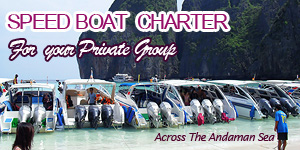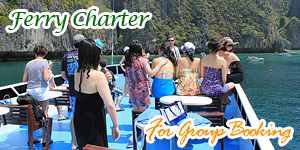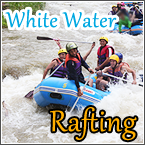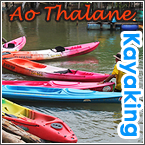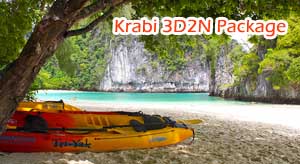Extreme Krabi
June 14, 2009 by admin
Filed under Articles On Krabi
Deep water soloing brings a new sense of adventure to a destination noted for its beaches, caves and lagoons
For decades Krabi’s abundant natural heritage that manifests itself through gorgeous white sand beaches, soaring limestone cliffs, magnificent viewpoints, caves and lagoons have served as a powerful magnet that draws an endless stream of visitors from all over the world. Other than its enchanting beauty which is undeniably unmatched, another feature that makes Krabi stand out from other island destinations is a diverse range of activities available both on land and under water, ideal for all breeds of travellers. Lined with rugged karst cliffs and wide expanses of white powdery beaches that slope down to crystal clear sea, the Railey Peninsula is much sought by avid rock climbers. The scenic peninsula is an extension of the mainland but inaccessible by road due totowering limestone cliffs that rise to cut it off from the road. Featuring numerous routes of varying degrees of difficulty and unlimited crags, Railey has become a world-class paradise for all levels of climbers, beginners as well as seasoned professionals. The average climber uses ropes, harness, quick draw and belay devices for safety but there is another breed that shuns them all just to fulfill their adrenaline-craving. Arriving at Poda Island, just 20 minutes by boat from Railey, I was dumbstruck watching two climbers bouldering up rocks without rope or safety equipment. This daring activity is called deep water soloing, a form of climbing practiced on cliffs perpendicular or leaning out to the sea, at high tide, with the sea being their only protection if they fall off. Deep water soloing, as it turns out, also happens to be a favourite of Pinyo Changrua, vice-chairman of Railey Rock Climbing Club, who disclosed that the activity was introduced to Krabi about five years ago by foreign tourists and it has increased in popularity ever since. Since deep water soloing entails higher risk than regular rock climbing, there are certain rules one must keep in mind. One, stick to a safe route, which means the water below must be at least five metres deep, and two, all adrenaline addicts must be aware of their physical strength and never try to exceed those limits. The higher you go, the harder you fall! According to Pinyo, budget travellers have taken a fancy for this extreme sport because it fits their low-cost lifestyle. “You don’t have to invest, taking climbing lesson or renting equipment. All you need is a pair of appropriate shoes and lots of courage,” he remarked. The next morning we decided to explore Krabi’s natural attractions by kayak. Equipped with necessary supplies enough to last the day, we set off for Bor Thor pier in Ao Luk district where we boarded the craft. The current gentle, we paddled at a leisurely pace through well-preserved mangrove areas, passing under the Lot Nua Cave, before stopping inside a lagoon sitting at the end of the next cave, Khao Wong. We lazed for a while dipping our feet in the brackish water soaking in the soft afternoon sun while our guide regaled us with his experience working as a kayak tour operator, a job which generates extra income for the local community relying mainly on fishing for a living. “This profession has been passed to Bor Thor residents down the generations. Most parents involved in kayak tours take their children with them when they go to work and let them acquire the necessary skills as well as the proficiency needed for the job through real-life experience,” he said. “I myself was brought up the same way.” At that point the roar of thunder warned us of imminent rain, prompting us to make our way to the final highlight of this trip as soon as possible. To that end, everyone paddled extra hard in a direction south of the lagoon. We got there in quick time, to Ao Luk’s most renowned cave, Tham Phi Hua Toh. This archaeological site was accidentally discovered by Kumad, the deputy head of Bor Thor village in 1984, when he sought shelter there from rain. Inside he spotted an oversized human skull together with several colourful rock paintings. Among all the caves in southern Thailand, these pre-historic paintings found on several sections of the roof and walls are believed to be the most varied. These 3,000-year-old paintings are incomparable in terms of uniqueness and historical significance. With quaint characters cleverly drawn in artful patterns, the evidence before our eyes, we felt, should make local inhabitants proud of their heritage and ancestral wisdom, for it is truly an invaluable method of ancient communication that preceded the age of the alphabet.
SOURCE : http://www.bangkokpost.com/travel/travelscoop/15916/extreme-krabi






